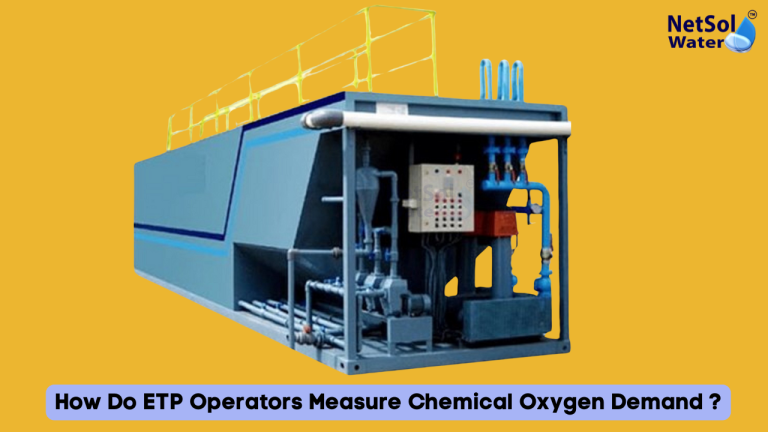
In Effluent Treatment Plants, water quality monitoring is necessary to effectively remove toxic pollutants before they are discharged back into the environment. Chemical Oxygen Demand, or COD, is one of the most significant tests used to quantify water pollution. But how do ETP operators measure Chemical Oxygen Demand and why? This log discusses what COD is, how ETP operators quantify it, and why this quantification is important for having clean water and assisting the environment.
What Is Chemical Oxygen Demand (COD)?
Chemical Oxygen Demand or COD is one way of measuring the amount of oxygen required to chemically decompose organic and inorganic materials contained in wastewater. Simply put, it tells us how much pollution or contamination of the water by estimating the total amount of oxygen required to oxidize all of the chemicals present in the sample.
COD is important because a high COD means there are many pollutants that will consume a lot of oxygen in natural bodies of water and kill aquatic life. Testing COD reminds operators how much pollution and how effectively treatment is working.
Why Do ETP Operators Conduct Chemical Oxygen Demand Tests?
ETP operators measure Chemical Oxygen Demand tests for several important reasons:
1) To Find Out Your Pollution Level: COD determines the concentration of organic and chemical pollutants in wastewater.
2) To Track Treatment Efficiency: COD before and after treatment is analyzed so that operators can ascertain whether the process is working properly.
3) To Comply with Regulates: The majority of environmental agencies only allow particular sets of COD levels to be released.
4) To Conserve Environment and Health: Lower COD indicates more pure water and healthier ecosystem.
Knowing the COD allows operators to implement corresponding measures to reduce pollution and improve water quality.
How Do ETP Operators Calculate Chemical Oxygen Demand?
Calculating COD requires laboratory testing with caution or sometimes directly at site using portable kits. The process includes the use of powerful chemicals and heating the sample for oxidizing the contaminants. Below is a concise description of the method through which ETP operators measure Chemical Oxygen Demand:
1) Sample Collection
ETP operators start off by collecting a representative sample of wastewater to be examined. Sampling the water in its present condition is very important, and therefore they may sample repeatedly over time or from different points.
2) Addition of a Chemical Oxidant
In the lab, the sample is combined with a powerful chemical oxidant. Potassium dichromate (K2Cr2O7) in an acidic medium is commonly employed. The oxidant acts to degrade the organic and inorganic matter in the wastewater.
3) Heating of the Sample
The mixture is heated, usually in a close vessel referred to as reflux apparatus, for about two hours. The heat speeds up the chemical reaction through which the impurities get oxidized. This is an extremely essential step since it ensures that the oxidant reacts completely with the sample.
4) Quantitating the Remaining Oxidant
When heated, the amount of oxidant used during the chemical reaction is measured. This is usually measured by titration, in which another chemical is added gradually, to the point of a reaction endpoint. The original and final amounts of the oxidant show the amount of oxygen that had to be used to break down the pollutants.
5) COD determination
Based on the titration results, ETP operators measure Chemical Oxygen Demand. It is expressed in units of milligrams per liter (mg/L) and is the equivalent of oxygen from pollutants in water.
Tools and Techniques Applied by ETP Operators
ETP operators utilize many different tools based on their facility:
A) Standard Laboratory Procedure: Most accurate and as specified by guidelines like those of the APHA or EPA. Reflux apparatus and titration are employed as previously detailed.
B) COD Test Kits: There are field kits that make quick on-site measurements possible. They use chemicals in vials and simple color comparison methods. Less precise but provide quick results.
C) Automated Analyzers: Some modern treatment plants use automated analyzers that continuously monitor COD and provide real-time results.
Safety Precautions
COD measurement is done using chemicals and acids. ETP operators should be properly dressed in safety gear such as gloves, goggles, and lab coats to protect them from injuries. Instructive instructions should be provided for safety reasons to avoid accidents and provide proper readings.
Issues with Measuring COD
Though COD measurement is extremely useful, some issues are encountered by ETP operators:
- Interference by Some Chemicals: Some chemicals present in wastewater may interfere with COD reading accuracy.
- Sample Storage: COD may be altered if samples are left for a long time before analysis. Operators should carry out analysis immediately or store samples under correct conditions.
- Complexity of Procedure: Reflux procedure requires experienced operators and lab equipment that may be lacking everywhere.
Notwithstanding these limitations, routine COD analysis continues to be a mainstay of water quality monitoring.
Conclusion
To maintain the quality of water bodies and to meet environmental standards, Effluent Treatment Plant operators measure Chemical Oxygen Demand as a significant factor in wastewater control. COD analysis helps in determining the extent of pollution and assists operators in controlling treatment procedures effectively. Operators efficiently treat wastewater through cautious sampling, chemical oxidation and titration, and interpretation of results. It is imperative to comprehend and manage COD to protect public health and the environment.
Do you need an advice or assistance on selecting the best water and waste water treatment unit? We have solutions for all your problems!
Let us know your problem, our experts will make sure that it goes away.
For an assistance or related query,
Call on +91-9650608473
Or write us at enquiry@netsolwater.com
